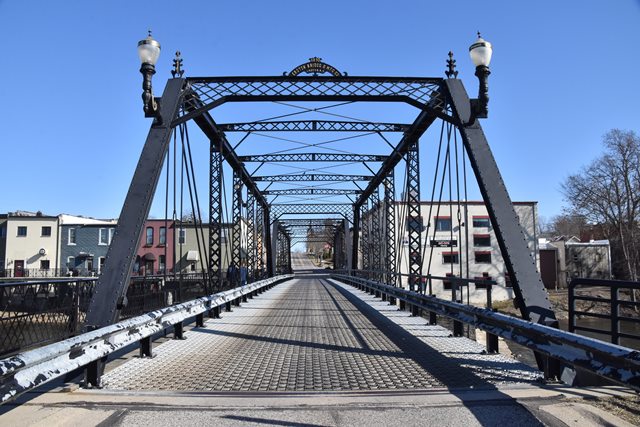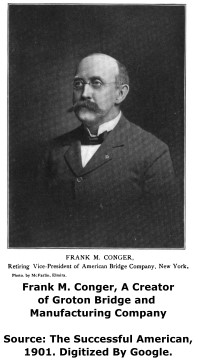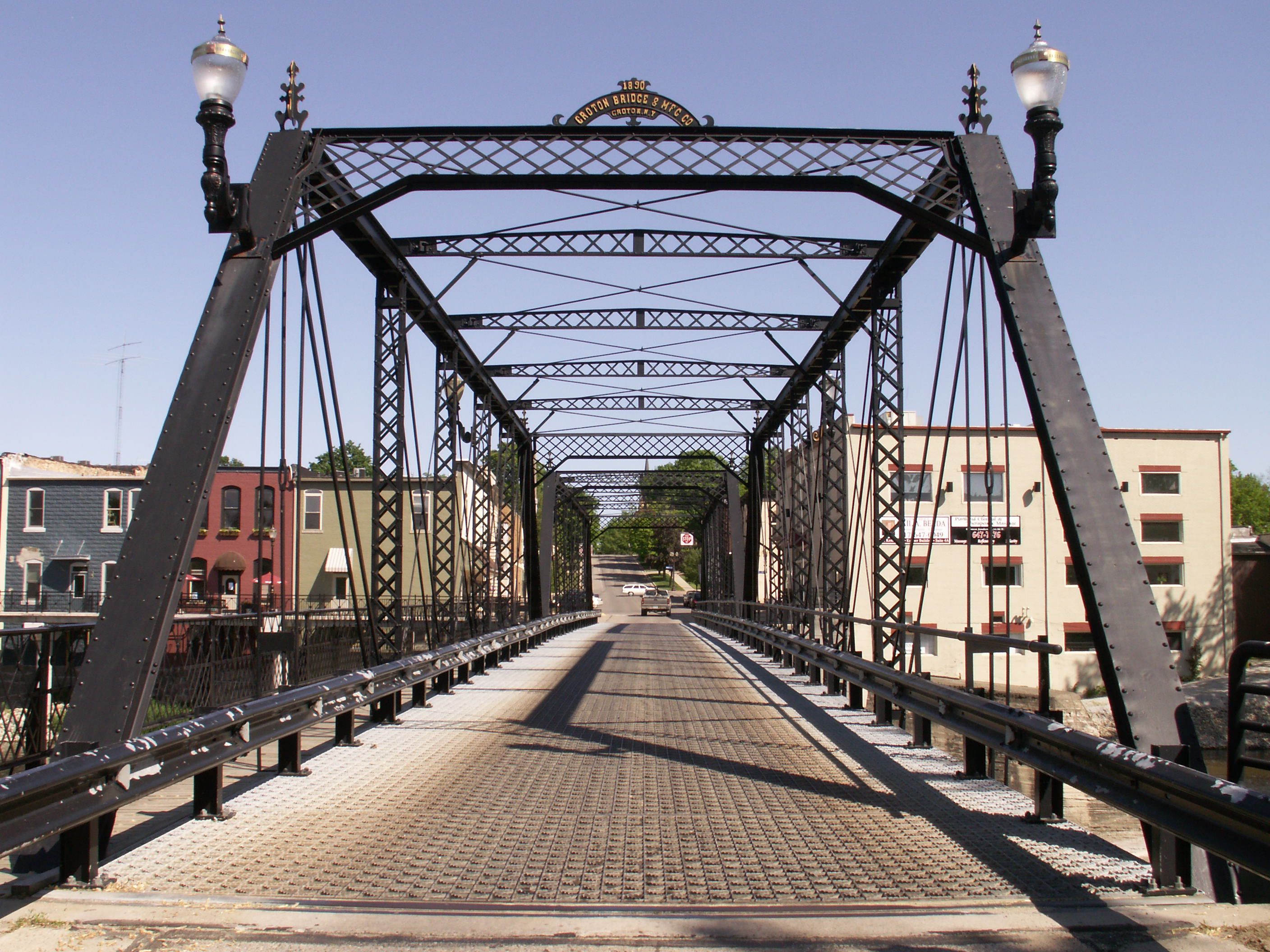We Recommend:
Bach Steel - Experts at historic truss bridge restoration.
BridgeHunter.com Phase 1 is released to the public! - Visit Now
Bridge Street Bridge
Veterans Memorial Bridge

Primary Photographer(s): Nathan Holth
Bridge Documented: Summer 2005 - March 20, 2022
Portland: Ionia County, Michigan: United States
1890 By Builder/Contractor: Groton Bridge Company of Groton, New York
1990
105.0 Feet (32 Meters)
210.0 Feet (64 Meters)
15 Feet (4.57 Meters)
2 Main Span(s)
344552000015B01

View Information About HSR Ratings
Bridge Documentation
This bridge is one of the largest (as a two-span example) and most complete examples of a rather ornate bridge plan/design that Groton Bridge and Manufacturing Company of Groton, NY built that remain today. As such it is significant on a national level as a key example of the work of an important bridge company. The bridge has been listed as a Michigan Historic Civil Engineering Landmark.
So many times a road or street in a city was named Bridge Street, and so often today that name sounds exciting but usually reveals an ugly slab bridge. This is one Bridge Street that deserves its name. Portland has treated their historic bridges well, and has even brought more historic bridges into their city from the surrounding rural area. Portland is a very special city that has embraced historic truss bridges as the key attraction to their city in a way that no other city has. They have preserved more truss bridges than any other city in Michigan. The city logo actually includes an abstract rendition of the trusses of this bridge as the main part of the logo. Portland is a model city for showing the important potential that historic bridges have to enrich a community.
This bridge is a two-span pin connected Pratt through truss. It was built in 1890 by the Groton Bridge Company of Groton New York. Plaques remain on top of the latticed portal bracing on this bridge. Decorative finials adorn the end posts of this bridge. V-lacing is present on vertical members. The sway bracing has a bit of a arch shape, and is latticed. The metal grate deck and modern Armco car guardrails are not original. Original ornate railing on the cantilevered sidewalks remain on the bridge.
This bridge forms an attractive, historic, and exciting entry into the downtown of Portland. It does not provide an exit however, as it is one-way. With a two-way crossing nearby, this was a fine way to eliminate the "dangers" that people in charge of bridges often fret about with historic one-lane bridges.
View Archived National Bridge Inventory Report - Has Additional Details and Evaluation
View Historic American Engineering Record (HAER) Documentation For This Bridge
View A Historical Article About Frank Conger, A Creator of Groton Bridge and Manufacturing Company
Above: Historical photo showing bridge in 1911 during a homecoming hose fight.
Above: Historical photo showing bridge ca. 1913.

Information and Findings From Michigan Historic Bridge InventoryThe Bridge Street bridge is a rare two-span metal through truss, with two spans 100 feet in length, featuring decorative treatment of the end posts. This is the oldest known surviving example of a truss bridge built in Michigan by the Gorton Bridge and Manufacturing Company of Gorton, New York, a significant eastern bridge manufacturing firm. |
This bridge is tagged with the following special condition(s): Unorganized Photos
![]()
Photo Galleries and Videos: Bridge Street Bridge
2005 Bridge Photo-Documentation
A collection of overview and detail photos. This photo gallery contains a combination of Original Size photos and Mobile Optimized photos in a touch-friendly popup viewer.Alternatively, Browse Without Using Viewer
![]()
Additional Unorganized Photos
Original / Full Size PhotosA supplemental collection of photos that are from additional visit(s) to the bridge and have not been organized or captioned. This gallery offers photos in the highest available resolution and file size in a touch-friendly popup viewer.
Alternatively, Browse Without Using Viewer
![]()
Additional Unorganized Photos
Mobile Optimized PhotosA supplemental collection of photos that are from additional visit(s) to the bridge and have not been organized or captioned. This gallery features data-friendly, fast-loading photos in a touch-friendly popup viewer.
Alternatively, Browse Without Using Viewer
![]()
Southbound Crossing
Full Motion VideoDriving southbound on this one-way bridge. Streaming video of the bridge. Also includes a higher quality downloadable video for greater clarity or offline viewing.
![]()
Maps and Links: Bridge Street Bridge
Coordinates (Latitude, Longitude):
Search For Additional Bridge Listings:
Bridgehunter.com: View listed bridges within 0.5 miles (0.8 kilometers) of this bridge.
Bridgehunter.com: View listed bridges within 10 miles (16 kilometers) of this bridge.
Additional Maps:
Google Streetview (If Available)
GeoHack (Additional Links and Coordinates)
Apple Maps (Via DuckDuckGo Search)
Apple Maps (Apple devices only)
Android: Open Location In Your Map or GPS App
Flickr Gallery (Find Nearby Photos)
Wikimedia Commons (Find Nearby Photos)
Directions Via Sygic For Android
Directions Via Sygic For iOS and Android Dolphin Browser
USGS National Map (United States Only)
Historical USGS Topo Maps (United States Only)
Historic Aerials (United States Only)
CalTopo Maps (United States Only)







